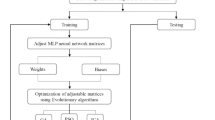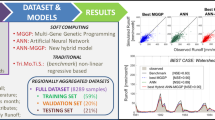Abstract
Estimation of suspended sediment yield is subject to uncertainty and bias. Many methods have been developed for estimating sediment yield but they still lack accuracy and robustness. This paper investigates the use of a machine-coded linear genetic programming (LGP) in daily suspended sediment estimation. The accuracy of LGP is compared with those of the Gene-expression programming (GEP), which is another branch of GP, and artificial neural network (ANN) technique. Daily streamflow and suspended sediment data from two stations on the Tongue River in Montana, USA, are used as case studies. Root mean square error (RMSE) and determination coefficient (R2) statistics are used for evaluating the accuracy of the models. Based on the comparison of the results, it is found that the LGP performs better than the GEP and ANN techniques. The GEP was also found to be better than the ANN. For the upstream and downstream stations, it is found that the LGP models with RMSE = 175 ton/day, R2 = 0.941 and RMSE = 254 ton/day, R2 = 0.959 in test period is superior in estimating daily suspended sediments than the best accurate GEP model with RMSE = 231 ton/day, R2 = 0.941 and RMSE = 331 ton/day, R2 = 0.934, respectively.
Similar content being viewed by others
References
Akaike H (1974) A new look at the statistical model identification. IEEE Trans Automat Contr 19(3):716–723
Ardiclioglu M, Kisi O, Haktanır T (2007) Suspended sediment prediction by using two different feed-forward backpropagation algorithms. Can J Civ Eng 34(1):1–6
ASCE Task Committee (2000) Artificial neural networks in hydrology. II: hydrological applications. J Hydrol Eng 5(1):124–137
Aytek A, Kisi O (2008) A genetic programming approach to suspended sediment modeling. J Hydrol 351(3–4):288–298
Aytek A, Guven A, Yüce MI, Aksoy H (2008) An explicit neural network formulation for evapotranspiration. Hydrol Sci J 53(4):893–904
Azamathulla HMd, Ghani AAb, Zakaria NA, Guven A (2010) Genetic programming to predict bridge pier scour. J Hydraul Eng 136(2):165–169
Babovic V (2000) Data mining and knowledge discovery in sediment transport. Comput-Aided Civil Infrastruct Eng 15(5):383–389
Babovic V, Keijzer M (2002) Declarative and preferential bias in GEP-based scientific discovery. Genetic Programming and Evolvable Machines 3(1):41–79
Banzhaf W, Nordin P, Keller RE, Francone FD (1998) Genetic programming. Kaufmann, San Francisco
Bhattacharya M, Abraham A, Nath B (2001) A linear genetic programming approach for modeling electricity demand prediction in Victoria. In: Proceedings of the hybrid information systems, first international workshop on hybrid intelligent systems, Adelaide, Australia, pp 379–393
Brameier M (2004) On linear genetic programming. Ph.D. thesis. University of Dortmund
Brameier M, Banzhaf W (2001) A comparison of linear genetic programming and neural networks in medical data mining. IEEE Trans Evol Comput 5(1):17–26
Cigizoglu HK (2004) Estimation and forecasting of daily suspended sediment data by multi layer perceptrons. Adv Water Resour 27:185–195
Cigizoglu HK, Kisi O (2006) Methods to improve the neural network performance in suspended sediment estimation. J Hydrol 317:221–238
Cobaner M, Unal B, Kisi O (2009) Suspended sediment concentration estimation by an adaptive neuro-fuzzy and neural network approaches using hydro-meteorological data. J Hydrol 367(1–2):52–61
Cousin N, Savic DA (1997) A rainfall-runoff model using genetic programming. Centre for Systems and Control Engineering, Report No. 97/03, School of Engineering, University of Exeter, Exeter, United Kingdom, p 70
Dorado J, Rabunal JR, Pazos A, Rivero D, Santos A, Puertas J (2003) Prediction and modeling of the rainfall-runoff transformation of a typical urban basin using ANN and GP. Appl Artif Intell 17(4):329–343
Ferreira C (2001) Gene expression programming: a new adaptive algorithm for solving problems. Complex Syst 13(1):87–129
Guven A (2009) Linear genetic programming for time-series modeling of daily flow rate. Earth Syst Sci 118(1):137–146
Guven A, Gunal M (2008a) Prediction of local scour downstream of grade-control structures using neural networks. J Hydraul Eng 134(11):1656–1660
Guven A, Gunal M (2008b) Genetic programming approach for prediction of local scour downstream hydraulic structures. J Irrig Drain Eng 134(1):241–249
Guven A, Gunal M, Cevik A (2006) Prediction of pressure fluctuations on stilling basins. Can J Civ Eng 33(11):1379–1388
Guven A, Aytek A, Yuce MI, Aksoy H (2008) Genetic programming-based empirical model for daily reference evapotranspiration estimation. Clean 36(10–11):905–912
Guven A, Azamathulla HMd, Zakaria NA (2009) Linear genetic programming for prediction of circular pile scour. J Ocean Eng 36(12–13):985–991
Harris EL, Babovic V, Falconer RA (2003) Velocity predictions in compound channels with vegetated floodplains using genetic programming. Int J River Basin Management 1(1):117–123
Kisi O (2004) Multi-layer perceptrons with Levenberg-Marquardt optimization algorithm for suspended sediment concentration prediction and estimation. Hydrol Sci J 49(3):1025–1040
Kisi O (2005) Suspended sediment estimation using neuro-fuzzy and neural network approaches. Hydrol Sci J 50(4):683–696
Kisi O (2007) Streamflow forecasting using different artificial neural network algorithms. J Hydrol Eng 12(5):532–539
Kisi O (2008) Constructing neural network sediment estimation models using a data-driven algorithm. Math Comput Simul 79(1):94–103
Kisi O, Guven A (2010) A machine code-based genetic programming for suspended sediment concentration estimation. Adv Eng Softw 41(7–8):939–945
Kisi O, Uncuoglu E (2005) Comparison of three backpropagation training algorithms for two case studies. Indian J Eng Mater Sci 12:443–450
Kisi O, Yuksel I, Dogan E (2008) Modeling daily suspended sediment of rivers in Turkey using several data driven techniques. Hydrol Sci J 53(3):1270–1285
Kizhisseri AS, Simmonds D, Rafiq Y, Borthwick M (2005) An evolutionary computation approach to sediment transport modeling. Fifth International Conference on Coastal Dynamics, 4–8 April 2005, Barcelona, Spain
Koza JR (1992) Genetic programming: on the programming of computers by means of natural selection. MIT, Cambridge
Lohani AK, Goel NK, Bhatia KKS (2007) Takagi–Sugeno fuzzy inference system for modeling stage–discharge relationship. J Hydrol 331(1–2):146–160
Oltean M, Grosan C (2003) A comparison of several linear genetic programming techniques. Complex Syst 14(1):1–29
Rabunal JR, Puertas J, Suarez J, Rivero D (2007) Determination of the unit hydrograph of a typical urban basin using genetic programming and artificial neural networks. Hydrol Process 21(4):476–485
Rai RK, Mathur BS (2008) Event-based sediment yield modeling using artificial neural network. Water Resour Manage 22(4):423–441
Savic DA, Godfrey AW, Davidson JW (1999) A genetic programming approach to rainfall-runoff modeling. Water Resour Manage 13(2):219–231
Singh KK, Pal M, Singh VP (2010) Estimation of mean annual flood in Indian catchments using backpropagation neural network and M5 model tree. Water Resour Manage 24(10):2007–2019
Sivapragasam C, Vasudevan G, Vincent P (2006) Effect of inflow forecast accuracy and operating time horizon in optimizing irrigation releases. Water Resour Manage 21(3):933–945
Talebizadeh M, Morid S, Ayyoubzadeh SA, Ghasemzadeh M (2010) Uncertainty analysis in sediment load modeling using ANN and SWAT model. Water Resour Manage 24(9):1747–1761
Tayfur G (2002) Artificial neural networks for sheet sediment transport. Hydrol Sci J 47(3):879–892
Tayfur G, Guldal V (2006) Artificial neural networks for estimating daily total suspended sediment in natural streams. Nord Hydrol 37(1):69–79
Whigham PA, Crapper PF (2001) Modeling rainfall-runoff using genetic programming. Math Comput Model 33(6–7):707–721
Zyserman JA, Fredsoe J (1994) Data analysis of bed concentration of suspended sediment. J Hydraul Eng 120(9):1021–1042
Author information
Authors and Affiliations
Corresponding author
Rights and permissions
About this article
Cite this article
Guven, A., Kişi, Ö. Estimation of Suspended Sediment Yield in Natural Rivers Using Machine-coded Linear Genetic Programming. Water Resour Manage 25, 691–704 (2011). https://doi.org/10.1007/s11269-010-9721-x
Received:
Accepted:
Published:
Issue Date:
DOI: https://doi.org/10.1007/s11269-010-9721-x




